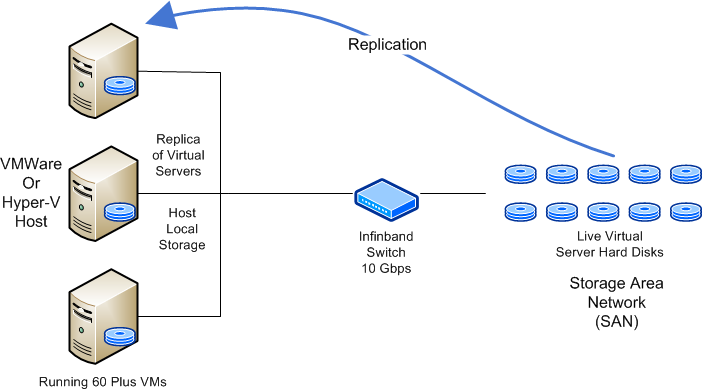Storage Area Networks
Contact us on 0121 314 0001 to discuss your SAN requirements.
This is We Solve IT's Recommended implementation of a Storage Area in a Virtualised Environment.

- Our solution of provides total redundancy if either a host or the SAN fail
- Due to the replica on the host’s local storage, you can recover from a SAN failure in under an hour
- With Virtual Server Hard Disks on the SAN in the event of Host failure VMs can be moved to other hosts while issues are resolved
- Maintenance on hosts can also be done with no downtime with Live Migration of Virtual Servers to other hosts
- Rolling replicas also allow for backup of files and settings, you can recover specific files and settings from the date of your choosing without full restore or any downtime
Storage Area Networks explained
This article offers an insight into the basics of traditional Storage Area Networks (SANs). However if you are looking for information regarding storage in a virtualised environment you will find our Storage Virtualisation page useful. Conversely, whilst an efficient Storage Area Network is a good start to a Disaster Recovery (DR) strategy, our DR services are discussed in more detail on our Disaster Recovery page.
Data is the underlying resource of which all computing processes are based, and such data is often a unique company asset. Since the turn of the century We Solve IT have been part of the continuous development of data storage over networks and as such have implemented cutting edge solutions for businesses. If you would like us to evaluate your requirements and to discuss which data storage network solution is a best fit for your company please contact us on 0121 3140001.
The storage requirements of companies today have grown exponentially over the last decade. To ensure company productivity the data needs to be easily and quickly accessible but also highly secure, reliable and configurable. The fundamental purpose of Storage Area Networks (SANs) is to transfer company data between their computer systems and storage elements.
The earliest approach to a storage network is Server Attached Storage (SAS). Whilst once highly popular it has now become quite unfashionable as more and more companies are moving away from this solution. SAS is facilitated by storage devices which are tightly coupled with the server bus using an adapter card. SAS usually relies on the Small Computer System Interface (SCSI) protocol, but as the storage is local to the server the preferred SCSI transport is usually Parallel SCSI. The significant limitation of this solution is its scalability. The number of storage devices that can be attached to the host server are limited by the parallel cables meaning that at certain points the introduction of additional storage devices require the implementation of new host servers. This has obvious cost implications as companies grow and data levels increase. Moreover, as additional servers are introduced the stored data is not easily shared between hosts. The functionality and manageability of the SAS approach is also limited by the difficulty of adding or removing storage without downtime implications.
As the cost and complexity of SANs reduced at the beginning of the century this led to an increase in their deployment by businesses. Storage Area Networks (SANs) have overcome the limitations of SAS. SANs provide a way to add storage without the downtime and disruption associated with server-attached storage upgrades. They also facilitate centralise data management, which greatly reduces overall operating costs compared to the aging SAS solution.
Business leaders are aware of the capital costs associated with implementing storage solutions as well as the operational expense in their maintenance. High-end disk drives, such as Fibre Channel (FC) drives, often account for a major portion of the total cost of storage networks. Naturally, businesses are now looking for cheaper alternatives to Fibre Chanel drives but obviously do not want to compromise the performance of their storage systems. The good news is that whilst the demand for storage solutions are increasing, the cost per Gigabyte is reducing. Consequently it is becoming more affordable for businesses to implement Storage Area Networks (SANs) and retain the company’s data for a longer period of time. The deployment of SANs are increasing dramatically, and this growth is expected to continue into the foreseeable future. There is a wider range of storage technologies which are available today as illustrated below.
Could not load widget with the id 122.
Connectivity within the SAN
Identifying which are the best storage devices to utilise within a SAN is only part of the problem. The data which is stored on these drives needs to be retrievable quickly and efficiently without any data loss over the network. Continuous connectivity is no longer a “nice to have” but is an essential requirement of modern businesses. What is also of utmost importance is the protection of the data that is stored, not only is important to retain data for the interest of the organisation, in many circumstances it is a legal requirement. Below is a selection of industry standards which are each worth consideration in overcoming the issues mentioned above.
Could not load widget with the id 123.



